check engine MAZDA 626 1987 Workshop Manual
[x] Cancel search | Manufacturer: MAZDA, Model Year: 1987, Model line: 626, Model: MAZDA 626 1987Pages: 1865, PDF Size: 94.35 MB
Page 660 of 1865

CONTROL SYSTEM 4C
Terminal Voltage
If the input and output devices wiring are normal, but the engine control unit terminal voltage is incor-
rect, replace the engine control unit.
Terminal Input Output Connection to Voltage (After warming-up) Remark Terminal Input Output Connection to Ign: ON Idle Remark
1A — — — — — —
1B o Self-Diagnosis Checker (Code No.)
For 3sec. after ignition switch OFF ->• ON: below 2.5V (Buzzer sounds) After 3sec.: approx. 12V (Buzzer does not sound)
• Using Self-Diagnosis Check-er and test con-nector grounded • Buzzer sounds: below 2.5V • Buzzer does not sound: approx. 12V
1C o
Solenoid valve (Variable inertia control) Approx. 12V
Above 5200 rpm (Unleaded fuel) or 5400 rpm (Leaded fuel): Below 2.5V
1D o Self-Diagnosis Checker (Monitor lamp)
For 3sec.after igni-tion switch OFF -» ON:
approx. 5V (light il-luminates)
After 3sec.: approx. 12V (light does not illuminate)
(Test connector grounded) approx. 5V (Test connector not grounded) Monitor lamp ON: approx. 5V Monitor lamp OFF: approx. 12V
With Self-Diagnosis
Checker
1E O Idle switch Accelerator pedal released: OV
Accelerator pedal depressed: approx. 12V
1F o A/C relay A/C switch ON: below 2.5V
A/C switch OFF: approx. 12V Blower motor ON
1G O Neutral or clutch switch
In-gear condition Clutch pedal depressed: approx. 12V Clutch pedal released: OV
MTX (Neutral: con-stant approx. 12V)
1H
(U/F) o Water thermo
switch
Approx. 12V Radiator temp.: be-low 17°C (63°R 1H
(U/F) o Water thermo
switch OV Radiator temp.:
above 17°C (63°F)
11 o Electrical load control unit E/L switch ON: below 2.5V
E/L switch OFF: approx. 10—12V
Electrical load: Rear defroster switch
Headlight switch Blower motor switch (3rd & 4th position) Electrical fan switch
1J — — — — —
1K o P/S pressure
switch
Constant approx.
12V
P/S ON: below 2.5V P/S OFF: approx. 12V
1L o A/C switch A/C switch ON: below 2.5V A/C switch OFF: aDDrox. 12V Blower motor: ON
1M o Distributor
(Ne signal) OV or 5V Approx. 2.0V
1N o Distributor (G signal) OV or 5V Approx. 1.2V
Note
Terminals labeled "U/F" are only for unleaded fuel.
4C-99
Page 663 of 1865
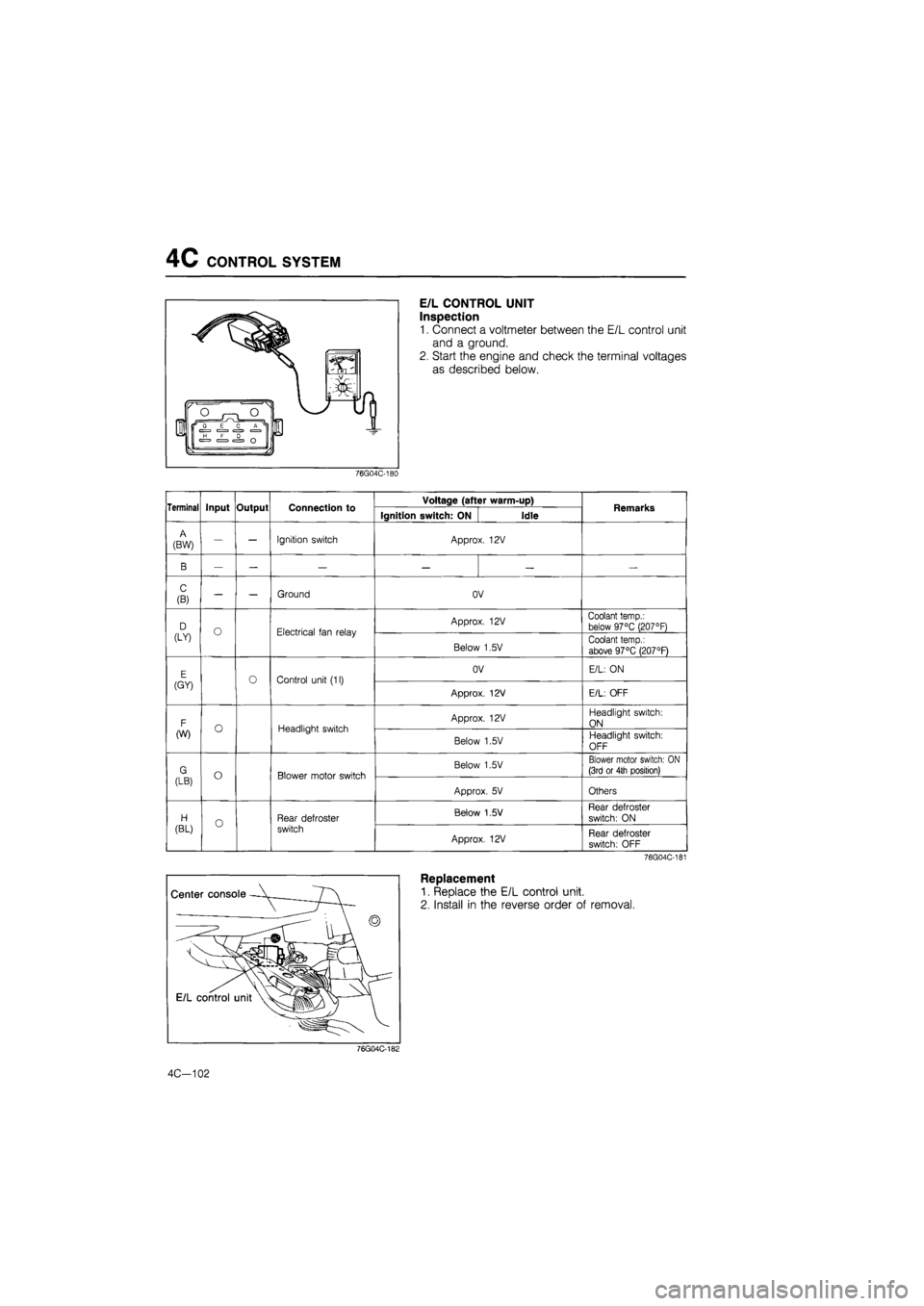
4C CONTROL SYSTEM
E/L CONTROL UNIT
Inspection
1. Connect a voltmeter between the E/L control unit
and a ground.
2. Start the engine and check the terminal voltages
as described below.
76G04C-180
Terminal Input Output Connection to Voltage (after warm-up) Remarks Terminal Input Output Connection to Ignition switch: ON Idle Remarks
A
(BW) — — Ignition switch Approx. 12V
B — — — — — —
C
(B) — — Ground OV
D (LY) O Electrical fan relay Approx. 12V Coolant temp.: below 97°C (207°F) D (LY) O Electrical fan relay
Below 1,5V Coolant temp.:
above 97°C (207°F)
E (GY) Control unit (11) OV E/L: ON E (GY) Control unit (11)
Approx. 12V E/L: OFF
F (W) O Headlight switch Approx. 12V Headlight switch:
ON F (W) O Headlight switch
Below 1,5V Headlight switch:
OFF
G (LB) o Blower motor switch Below 1.5V Blower motor switch: ON (3rd or 4th position) G (LB) o Blower motor switch
Approx. 5V Others
H
(BL) o Rear defroster
switch
Below 1.5 V Rear defroster
switch: ON H
(BL) o Rear defroster
switch Approx. 12V Rear defroster switch: OFF
76G04C-181
Replacement
1. Replace the E/L control unit.
2. Install in the reverse order of removal.
76G04C-182
4C—102
Page 664 of 1865
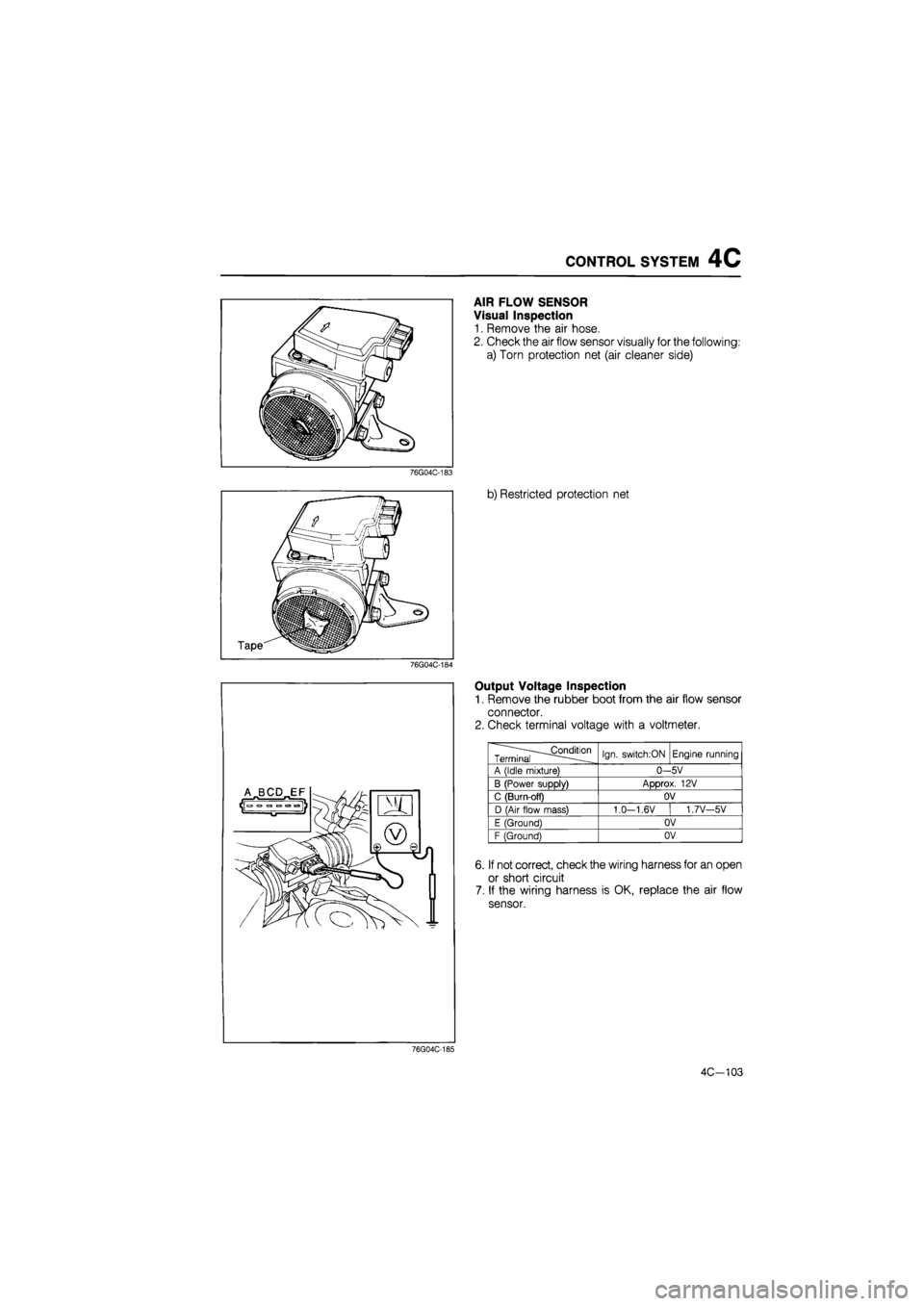
CONTROL SYSTEM 4C
AIR FLOW SENSOR
Visual Inspection
1. Remove the air hose.
2. Check the air flow sensor visually for the following:
a) Torn protection net (air cleaner side)
76G04C-183
b) Restricted protection net
76G04C-184
Output Voltage Inspection
1. Remove the rubber boot from the air flow sensor
connector.
2. Check terminal voltage with a voltmeter.
——^.Condition Terminal — ... Ign. switch;ON Engine running
A (Idle mixture) 0—5V
B (Power supply) Approx. 12V
C (Burn-off) OV
D (Air flow mass) 1.0-1,6V I 1.7V-5V
E (Ground) OV
F (Ground) 0V
6. If not correct, check the wiring harness for an open
or short circuit
7. If the wiring harness is OK, replace the air flow
sensor.
76G04C-185
4C-103
Page 665 of 1865
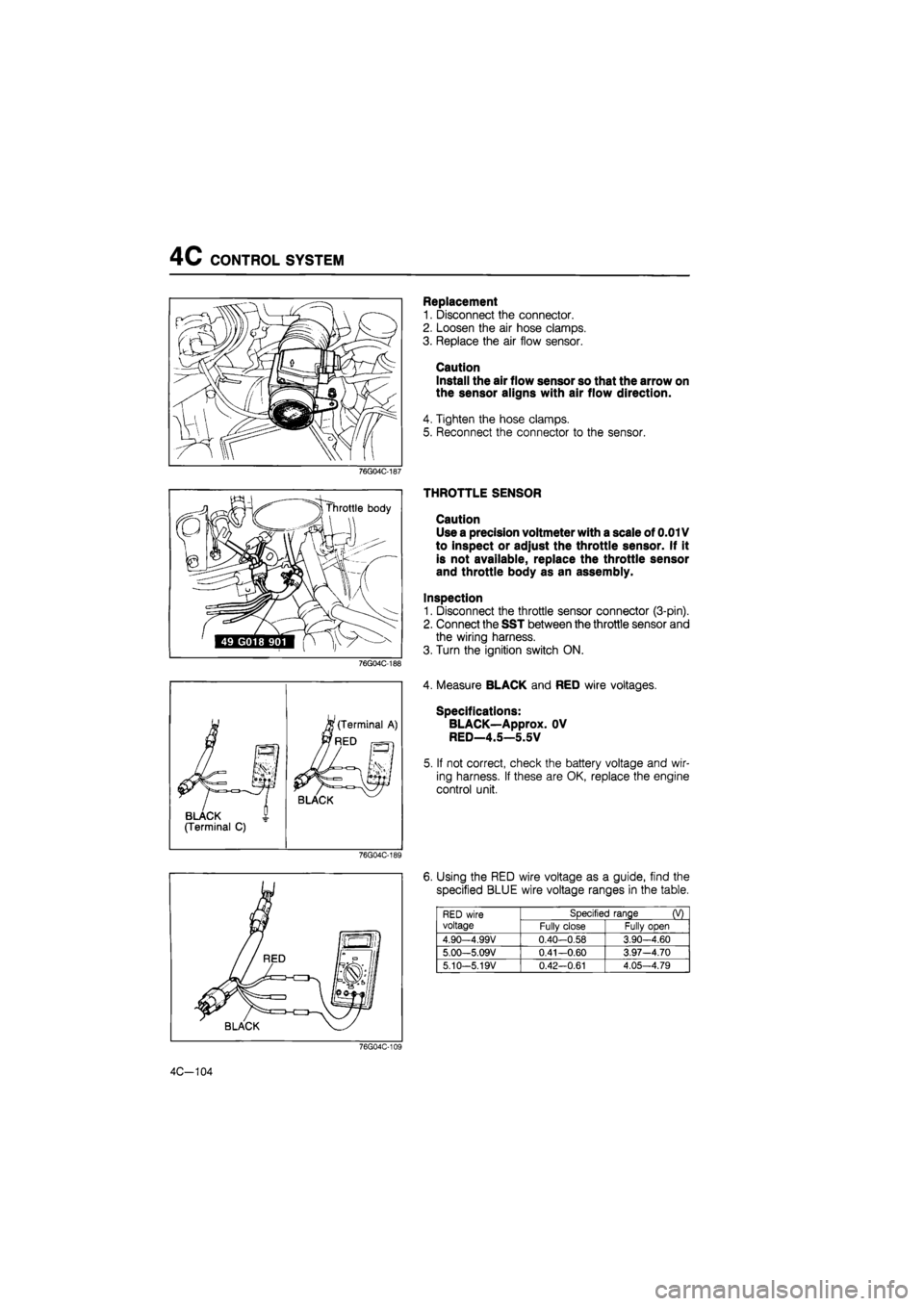
4C CONTROL SYSTEM
Jjf (Terminal A)
n PI
WRED r^j
BLACK
BLACK 1 (Terminal C)
76G04C-189
Replacement
1. Disconnect the connector.
2. Loosen the air hose clamps.
3. Replace the air flow sensor.
Caution
Install the air flow sensor so that the arrow on
the sensor aligns with air flow direction.
4. Tighten the hose clamps.
5. Reconnect the connector to the sensor.
THROTTLE SENSOR
Caution
Use a precision voltmeter with a scale of 0.01V
to inspect or adjust the throttle sensor. If it
is not available, replace the throttle sensor
and throttle body as an assembly.
Inspection
1. Disconnect the throttle sensor connector (3-pin).
2. Connect the SST between the throttle sensor and
the wiring harness.
3. Turn the ignition switch ON.
4. Measure BLACK and RED wire voltages.
Specifications:
BLACK—Approx. OV
RED—4.5—5.5V
5. If not correct, check the battery voltage and wir-
ing harness. If these are OK, replace the engine
control unit.
6. Using the RED wire voltage as a guide, find the
specified BLUE wire voltage ranges in the table.
RED wire voltage
Specified range (V) RED wire voltage Fully close Fully open
4.90—4.99V 0.40-0.58 3.90-4.60
5.00—5.09V 0.41—0.60 3.97-4.70
5.10-5.19V 0.42—0.61 4.05—4.79
4C-104
Page 668 of 1865
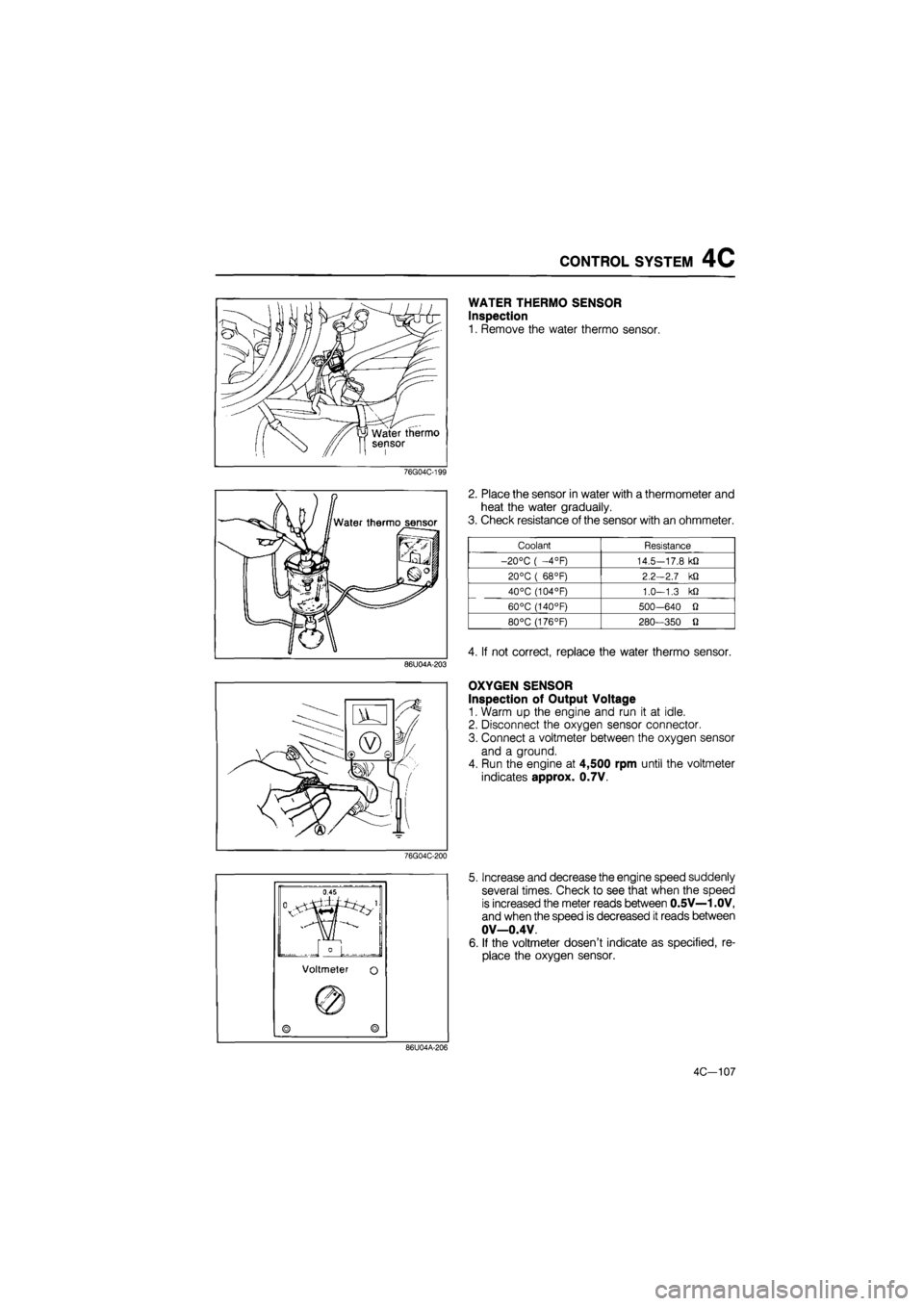
CONTROL SYSTEM 4C
WATER THERMO SENSOR
Inspection
1. Remove the water thermo sensor.
76G04C-199
86U04A-203
2. Place the sensor in water with a thermometer and
heat the water gradually.
3. Check resistance of the sensor with an ohmmeter.
Coolant Resistance
-20°C ( —4°F) 14.5—17.8 kfl
20°C ( 68°F) 2.2-2.7 kQ
40°C (104°F) 1.0—1.3 kQ
60°C (140°F) 500—640 O
80°C (176°F) 280—350 fl
4. If not correct, replace the water thermo sensor.
OXYGEN SENSOR
Inspection of Output Voltage
1. Warm up the engine and run it at idle.
2. Disconnect the oxygen sensor connector.
3. Connect a voltmeter between the oxygen sensor
and a ground.
4. Run the engine at 4,500 rpm until the voltmeter
indicates approx. 0.7V.
76G04C-200
5. Increase and decrease the engine speed suddenly
several times. Check to see that when the speed
is increased the meter reads between 0.5V—1 .OV,
and when the speed is decreased it reads between
OV—0.4V.
6. If the voltmeter dosen't indicate as specified, re-
place the oxygen sensor.
86U04A-206
4C—107
Page 669 of 1865
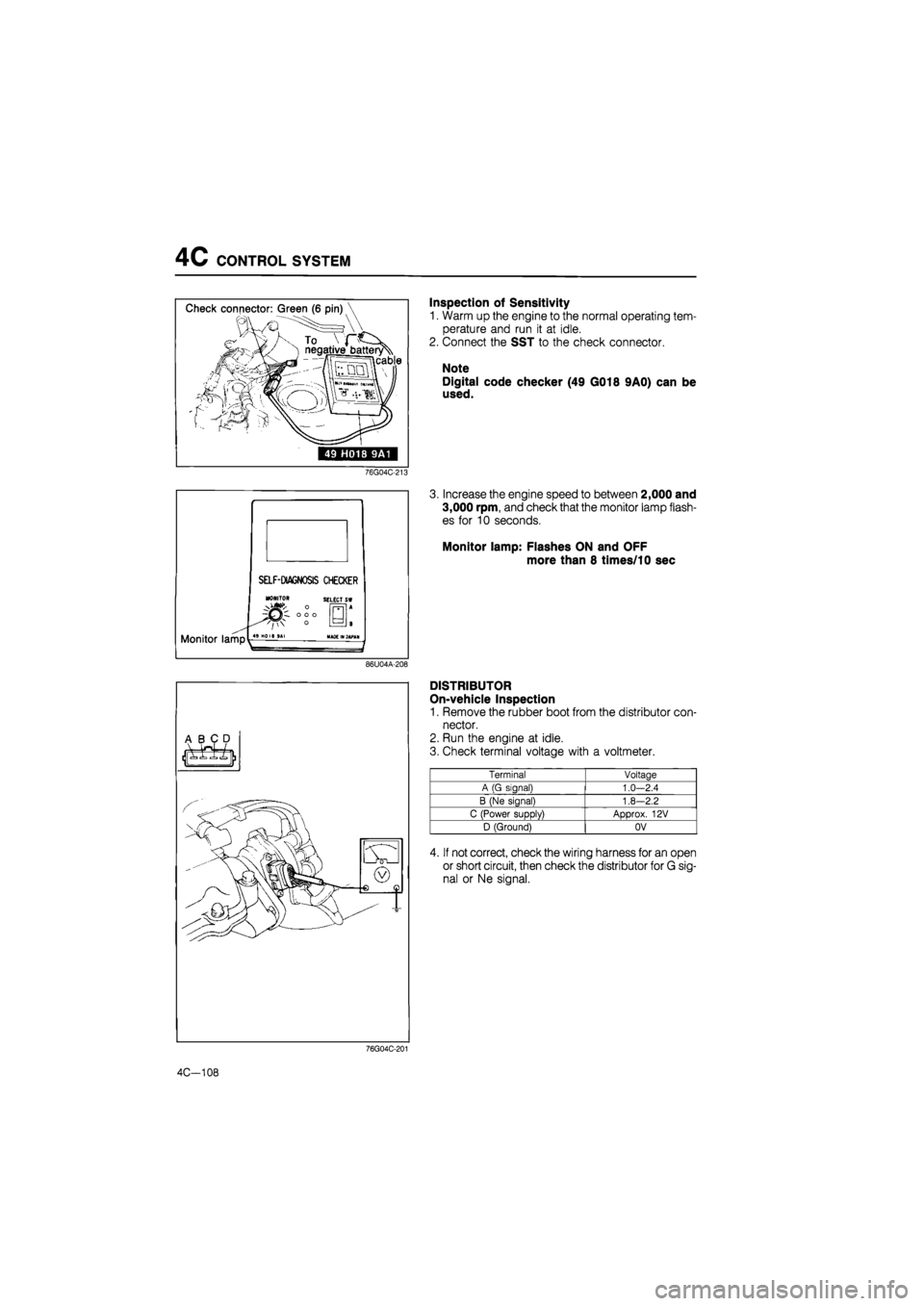
4C CONTROL SYSTEM
Check connector: Green (6 pin)
cable
49 H018 9A1
Inspection of Sensitivity
1. Warm up the engine to the normal operating tem-
perature and run it at idle.
2. Connect the SST to the check connector.
Note
Digital code checker (49 G018 9A0) can be
used.
76G04C-213
Increase the engine speed to between 2,000 and
3,000 rpm, and check that the monitor lamp flash-
es for 10 seconds.
Monitor lamp: Flashes ON and OFF
more than 8 times/10 sec
86U04A-208
A B C D
/llkw^ - ®
I « ^
76G04C-201
4C—108
DISTRIBUTOR
On-vehicle Inspection
1. Remove the rubber boot from the distributor con-
nector.
2. Run the engine at idle.
3. Check terminal voltage with a voltmeter.
Terminal Voltaae
A (G signal) 1.0—2.4
B (Ne sianaB 1.8—2.2
C (Power supply) Approx. 12V
D (Ground) OV
4. If not correct, check the wiring harness for an open
or short circuit, then check the distributor for G sig-
nal or Ne signal.
Page 670 of 1865
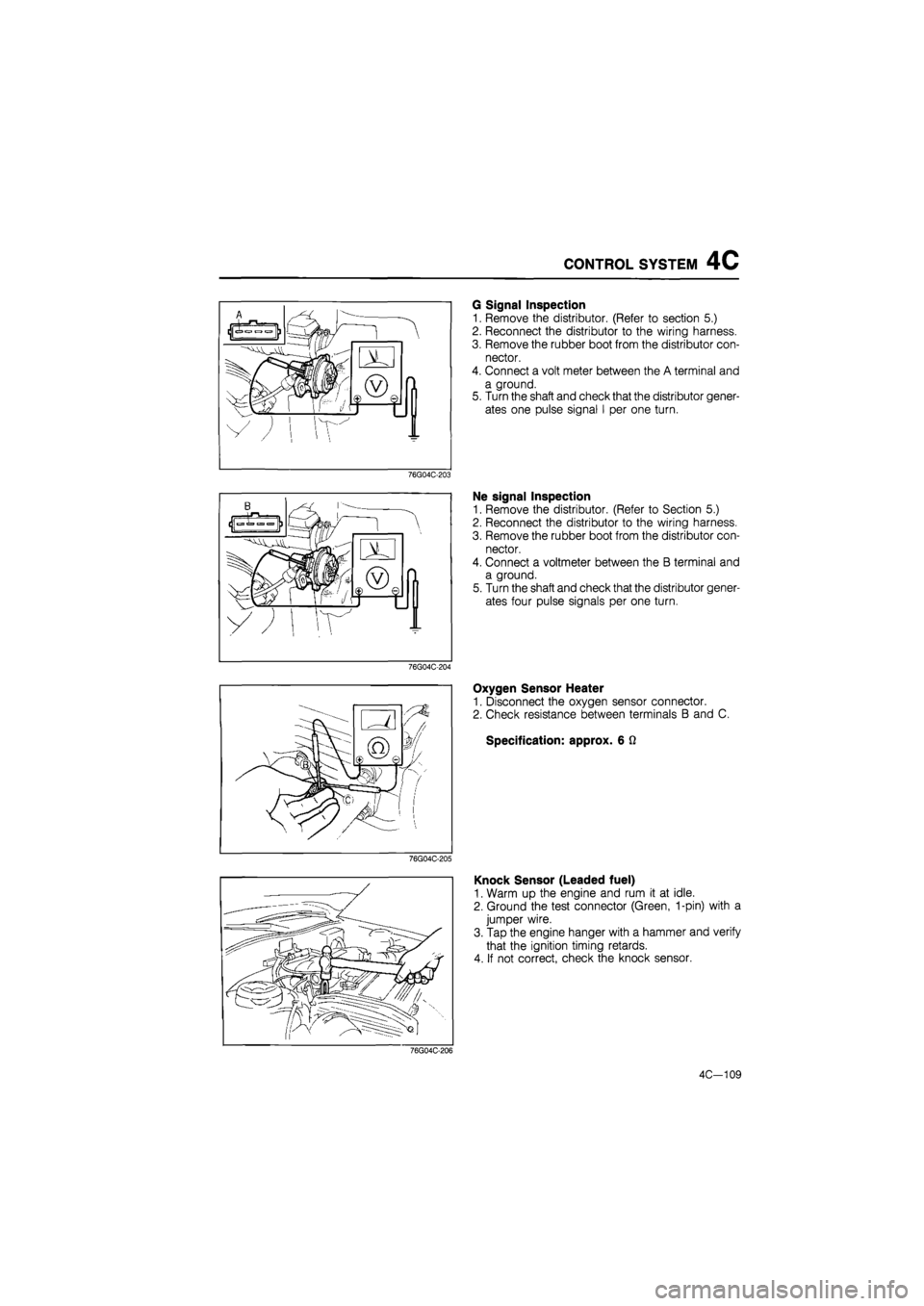
CONTROL SYSTEM 4C
76G04C-203
76G04C-204
76G04C-205
G Signal Inspection
1. Remove the distributor. (Refer to section 5.)
2. Reconnect the distributor to the wiring harness.
3. Remove the rubber boot from the distributor con-
nector.
4. Connect a volt meter between the A terminal and
a ground.
5. Turn the shaft and check that the distributor gener-
ates one pulse signal I per one turn.
Ne signal Inspection
1. Remove the distributor. (Refer to Section 5.)
2. Reconnect the distributor to the wiring harness.
3. Remove the rubber boot from the distributor con-
nector.
4. Connect a voltmeter between the B terminal and
a ground.
5. Turn the shaft and check that the distributor gener-
ates four pulse signals per one turn.
Oxygen Sensor Heater
1. Disconnect the oxygen sensor connector.
2. Check resistance between terminals B and C.
Specification: approx. 6 Q
Knock Sensor (Leaded fuel)
1. Warm up the engine and rum it at idle.
2. Ground the test connector (Green, 1-pin) with a
jumper wire.
3. Tap the engine hanger with a hammer and verify
that the ignition timing retards.
4. If not correct, check the knock sensor.
76G04C-206
4C-109
Page 677 of 1865

4D ON-VEHICLE MAINTENANCE
IDLE SPEED
1. Warm up the engine to normal operating tem-
perature.
2. Be sure the A/C switch is OFF.
3. Connect a tachometer and check the engine
speed.
Idle speed: 720 :
20
rpm
76G04D-012
4. If necessary, adjust the idle by turning the idle ad-
justing screw.
76G04D-013
Fast Idle Speed (A/C equipped model)
1. Turn ON the A/C switch and blower motor switch.
2. Check the engine speed.
Fast idle speed: 725 ± 25 rpm
3. If necessary, turn the adjusting screw on the idle-
up actuator, and adjust the fast idle speed.
76G04D-014
EXHAUST SMOKE
Increase and decrease the engine speed several
times and check that there is no black smoke.
If
there
is, refer to the Troubleshooting Guide.
76G04D-015
4D—6
Page 682 of 1865

4D SUPERCHARGING SYSTEM (RF-CX)
ON-VEHICLE INSPECTION
Boost Pressure
1. Connect a pressure gauge to the hose from the
intake manifold.
2. (On chassis dynomometer, full load)
(1) Set the vehicle on a chassis dynomometer.
(2) Run the vehicle in gear at 3,000 rpm with the
acceleration pedal fully depressed.
(3) Measure the boost pressure.
Boost pressure:
82 kPa (0.87 kg/cm2, 8.1 psi)
Note
The above inspection should be done on a
chassis dynomometer. If a dynomometer is
not available follow the below procedure.
3. (Off chassis dynomometer, no load)
(1) Shift the transaxle out off gear.
(2) Run the engine in neutral at 3,000 rpm of the
engine no load.
Measure the boost pressure.
Boost pressure:
5 kPa (0.05 kg/cm2, 0.7 psi)
Note
The boost pressure is varied by engine speed
and engine load.
(3) Remove the starting valve bypass hose.
(4) Check that the bypass valve is closed at 3,000
rpm.
4.
If
the pressure is below specification, check the fol-
lowing. Replace the Comprex supercharger if
necessary.
(1) Intake air and exhaust passages leakage
(2) Intake air and exhaust passages clogged
(3) Wastegate (Refer to 4D—12.)
(4) Starting valve (Refer to 4D—15.)
(5) Fuel system (Injection nozzle... refer to page
4D—31, injection pump...refer to page 4D—24,
etc.)
5. If the pressure exceeds specification, check the
wastegate operation. (Refer to page 4D—12.)
4D—11
Page 695 of 1865

4D FUEL SYSTEM
INJECTION PUMP
On-Vehicle Inspection
Fuel cut solenoid valve
1. Run the engine at idle.
2. Disconnect the solenoid valve connector, and let
the engine stop.
3. If the engine does not stop, replace the fuel cut
solenoid valve.
76G04D-055
Pick up coil
1. Disconnect the pick up coil connector.
2. Check for continuity of the coil using an ohmmeter.
3. Replace it if there is not continuity.
76G04D-056
O
o
>=
=<
t= —i V
' 1 -4
n
5-
U
o
1 mm (0.39 in) Injection Timing Adjustment
Inspection
Check the injection timing. (Refer to page 4D—5.)
Injection timing
RF-CX: ATDC 10
RF-N : TDC 0°
76G04D-057
Adjustment
1. Loosen the injection pump mounting nut.
2. Loosen the injection pump bracket bolt.
76G04D-058
4D—24